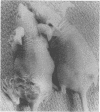Abstract
Treatment of herpes simplex virus (HSV)-infected hairless mice with a 2% phosphonoacetic acid (PAA) ointment prevented the appearance of virus-induced skin lesions and subsequent central nervous system (CNS) involvement. Treatment started 24 h after infection significantly reduced the intensity of the skin lesions and also prevented CNS involvement. After four to six applications of PAA ointment, a moderate skin erythemia developed, followed by scaling and complete healing 7 days after cessation of the treatment. Mice treated early after HSV infection had low or undetectable levels of virus-specific antibodies but were completely resistant to reinfection. Early treatment prevented the development of a latent ganglionic infection, but treatment initiated 24 h after infection could not prevent the establishment of the latent infection. PAA-treated and HSV-infected mice with nondetectable levels of antibodies did not develop, with a single exception, a latent ganglionic infection unpon reinfection. The cell-mediated immune response determined by levels of [14C]thymidine incorporation in Ficoll-Hypaque-purified spleen lymphocytes cultures was low in PAA-treated mice; it increased slightly after challenge infection but was strong in mice that proved to harbor a latent HSV infection in the ganglia.
Full text
PDF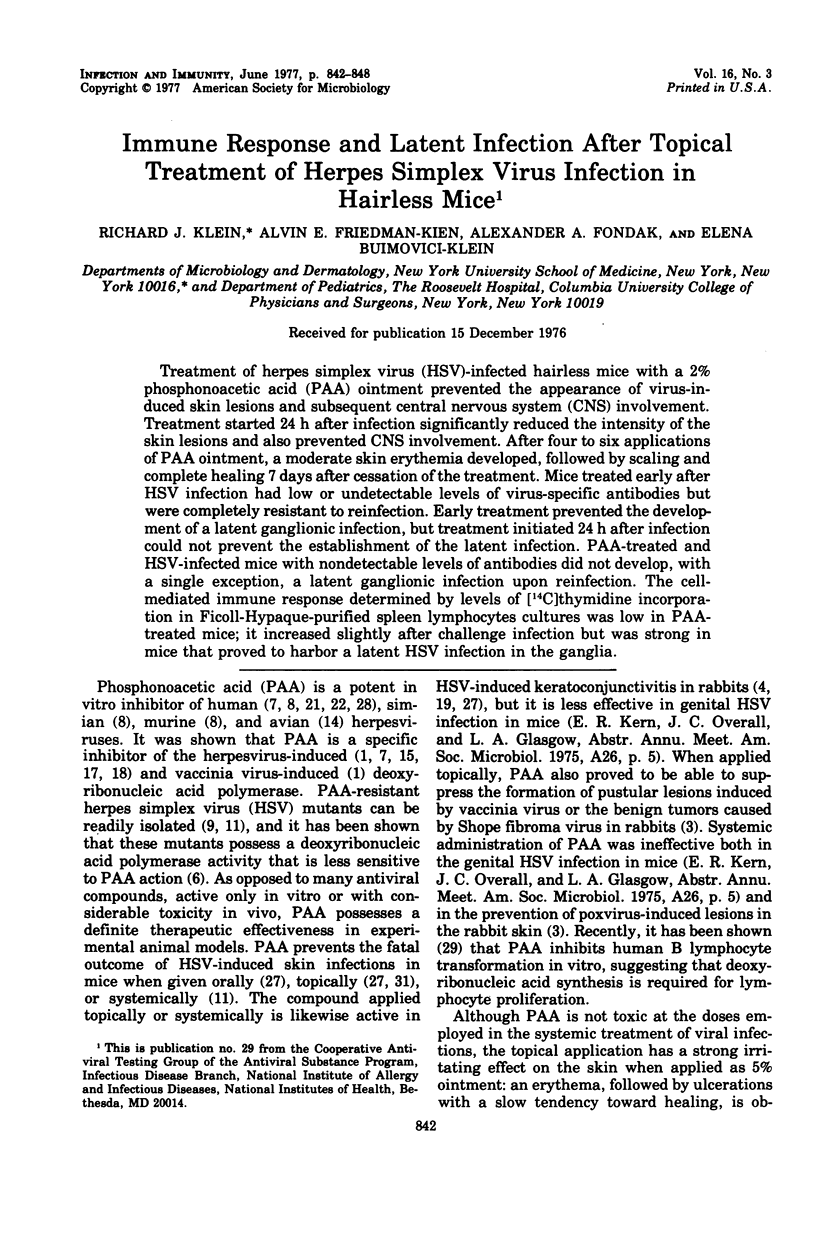

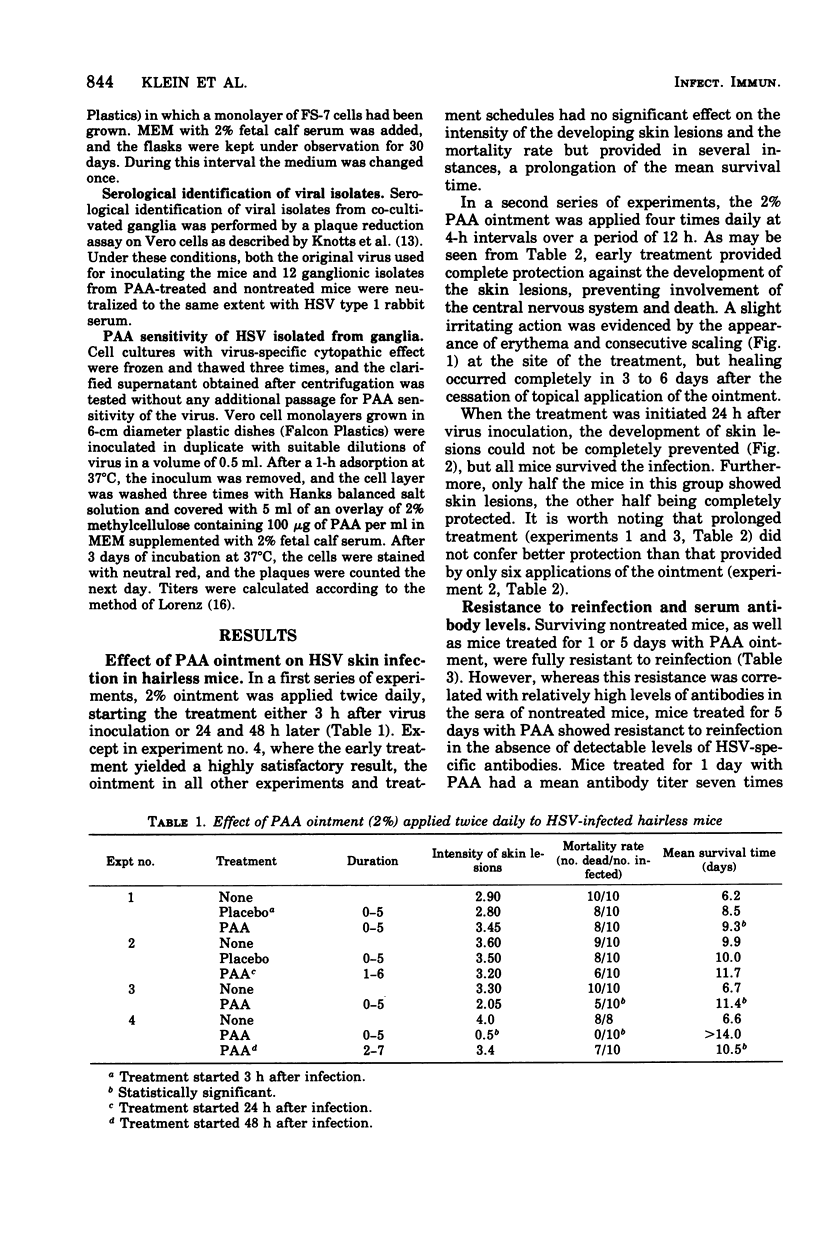
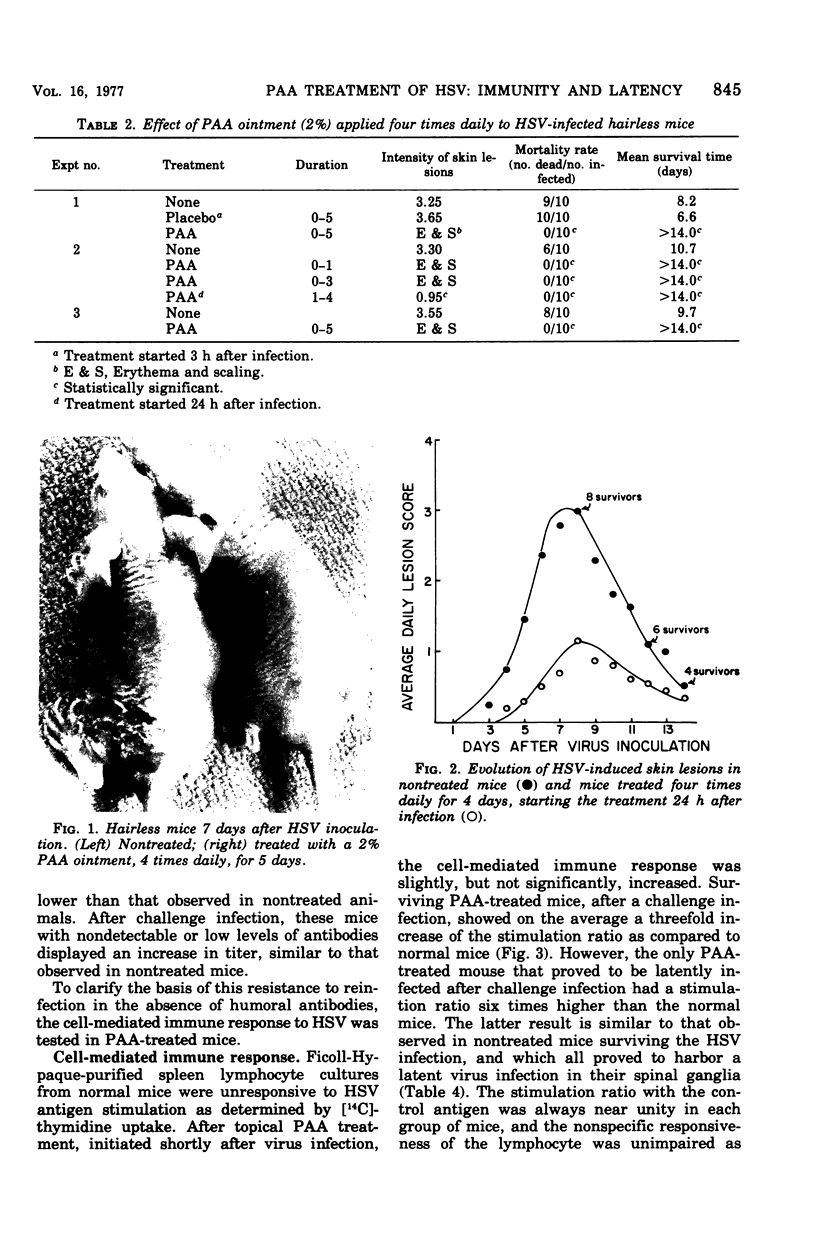
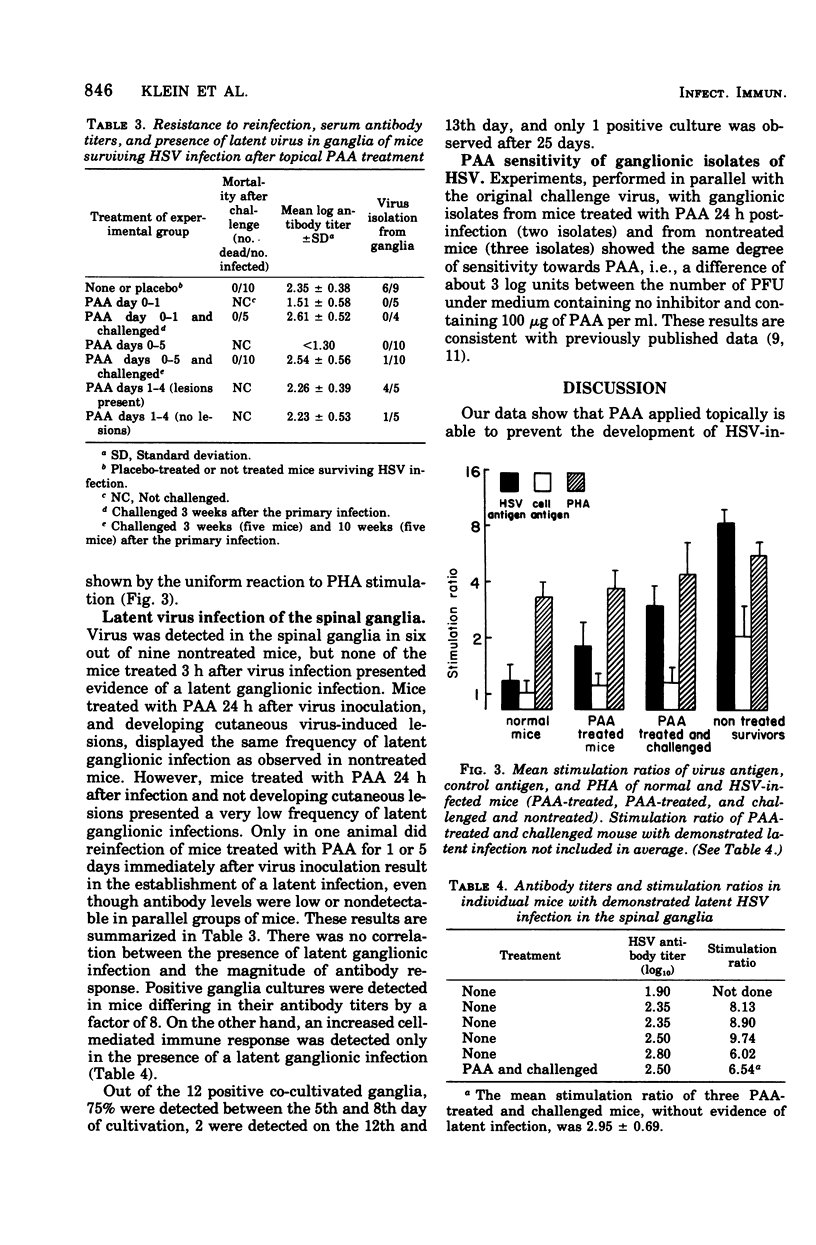


Images in this article
Selected References
These references are in PubMed. This may not be the complete list of references from this article.
- Bolden A., Aucker J., Weissbach A. Synthesis of herpes simplex virus, vaccinia virus, and adenovirus DNA in isolated HeLa cell nuclei. I. Effect of viral-specific antisera and phosphonoacetic acid. J Virol. 1975 Dec;16(6):1584–1592. doi: 10.1128/jvi.16.6.1584-1592.1975. [DOI] [PMC free article] [PubMed] [Google Scholar]
- Friedman-Kien A. E., Fondak A. A., Klein R. J. Phosphonoacetic acid treatment of shope fibroma and vaccinia virus skin infections in rabbits. J Invest Dermatol. 1976 Feb;66(02):99–102. doi: 10.1111/1523-1747.ep12481437. [DOI] [PubMed] [Google Scholar]
- Gerstein D. D., Dawson C. R., O J. O. Phosphonoacetic acid in the treatment of experimental herpes simplex keratitis. Antimicrob Agents Chemother. 1975 Mar;7(3):285–288. doi: 10.1128/aac.7.3.285. [DOI] [PMC free article] [PubMed] [Google Scholar]
- Haahr S., Rasmussen L., Merigan T. C. Lymphocyte transformation and interferon production in human mononuclear cell microcultures for assay of cellular immunity to herpes simplex virus. Infect Immun. 1976 Jul;14(1):47–54. doi: 10.1128/iai.14.1.47-54.1976. [DOI] [PMC free article] [PubMed] [Google Scholar]
- Hay J., Subak-Sharpe J. H. Mutants of herpes simplex virus types 1 and 2 that are resistant to phosphonoacetic acid induce altered DNA polymerase activities in infected cells. J Gen Virol. 1976 Apr;31(1):145–148. doi: 10.1099/0022-1317-31-1-145. [DOI] [PubMed] [Google Scholar]
- Huang E. S., Huang C. H., Huong S. M., Selgrade M. Preferential inhibition of herpes-group viruses by phosphonoacetic acid: effect on virus DNA synthesis and virus-induced DNA polymerase activity. Yale J Biol Med. 1976 Mar;49(1):93–99. [PMC free article] [PubMed] [Google Scholar]
- Huang E. S. Human cytomegalovirus. IV. Specific inhibition of virus-induced DNA polymerase activity and viral DNA replication by phosphonoacetic acid. J Virol. 1975 Dec;16(6):1560–1565. doi: 10.1128/jvi.16.6.1560-1565.1975. [DOI] [PMC free article] [PubMed] [Google Scholar]
- Klein R. J., Friedman-Kien A. E., Brady E. Herpes simplex virus skin infection in hairless mice: treatment with antiviral compounds. Antimicrob Agents Chemother. 1974 Mar;5(3):318–322. doi: 10.1128/aac.5.3.318. [DOI] [PMC free article] [PubMed] [Google Scholar]
- Klein R. J., Friedman-Kien A. E. Phosphonoacetic acid-resistant herpes simplex virus infection in hairless mice. Antimicrob Agents Chemother. 1975 Mar;7(3):289–293. doi: 10.1128/aac.7.3.289. [DOI] [PMC free article] [PubMed] [Google Scholar]
- Klein R. J. Isolation of herpes simplex virus clones and drug resistant mutants in microcultures. Arch Virol. 1975;49(1):73–80. doi: 10.1007/BF02175598. [DOI] [PubMed] [Google Scholar]
- Klein R. J. Pathogenetic mechansims of recurrent herpes simplex virus infections. Arch Virol. 1976;51(1-2):1–13. doi: 10.1007/BF01317829. [DOI] [PubMed] [Google Scholar]
- Knotts F. B., Cook M. L., Stevens J. G. Latent herpes simplex virus in the central nervous system of rabbits and mice. J Exp Med. 1973 Sep 1;138(3):740–744. doi: 10.1084/jem.138.3.740. [DOI] [PMC free article] [PubMed] [Google Scholar]
- LORNEZ R. J. [On statistics of the plaque test]. Arch Gesamte Virusforsch. 1962;12:108–137. [PubMed] [Google Scholar]
- Lee L. F., Nazerian K., Leinbach S. S., Reno J. M., Boezi J. A. Effect of phosphonoacetate on Marek's disease virus replication. J Natl Cancer Inst. 1976 Apr;56(4):823–827. doi: 10.1093/jnci/56.4.823. [DOI] [PubMed] [Google Scholar]
- Leinbach S. S., Reno J. M., Lee L. F., Isbell A. F., Boezi J. A. Mechanism of phosphonoacetate inhibition of herpesvirus-induced DNA polymerase. Biochemistry. 1976 Jan 27;15(2):426–430. doi: 10.1021/bi00647a029. [DOI] [PubMed] [Google Scholar]
- Mao J. C., Robishaw E. E. Mode of inhibition of herpes simplex virus DNA polymerase by phosphonoacetate. Biochemistry. 1975 Dec 16;14(25):5475–5479. doi: 10.1021/bi00696a015. [DOI] [PubMed] [Google Scholar]
- Mao J. C., Robishaw E. E., Overby L. R. Inhibition of DNA polymerase from herpes simplex virus-infected wi-38 cells by phosphonoacetic Acid. J Virol. 1975 May;15(5):1281–1283. doi: 10.1128/jvi.15.5.1281-1283.1975. [DOI] [PMC free article] [PubMed] [Google Scholar]
- Meyer R. F., Varnell E. D., Kaufman H. E. Phosphonoacetic acid in the treatment of experimental ocular herpes simplex infections. Antimicrob Agents Chemother. 1976 Feb;9(2):308–311. doi: 10.1128/aac.9.2.308. [DOI] [PMC free article] [PubMed] [Google Scholar]
- Nahmias A. J., Shore S. L., Kohl S., Starr S. E., Ashman R. B. Immunology of herpes simplex virus infection: relevance to herpes simplex virus vaccines and cervical cancer. Cancer Res. 1976 Feb;36(2 Pt 2):836–844. [PubMed] [Google Scholar]
- Nyormoi O., Thorley-Lawson D. A., Elkington J., Strominger J. L. Differential effect of phosphonoacetic acid on the expression of Epstein-Barr viral antigens and virus production. Proc Natl Acad Sci U S A. 1976 May;73(5):1745–1748. doi: 10.1073/pnas.73.5.1745. [DOI] [PMC free article] [PubMed] [Google Scholar]
- Overby L. R., Robishaw E. E., Schleicher J. B., Rueter A., Shipkowitz N. L., Mao J. C. Inhibition of herpes simplex virus replication by phosphonoacetic acid. Antimicrob Agents Chemother. 1974 Sep;6(3):360–365. doi: 10.1128/aac.6.3.360. [DOI] [PMC free article] [PubMed] [Google Scholar]
- Price R. W., Walz M. A., Wohlenberg C., Notkins A. L. Latent infection of sensory ganglia with herpes simplex virus: efficacy of immunization. Science. 1975 May 30;188(4191):938–940. doi: 10.1126/science.166432. [DOI] [PubMed] [Google Scholar]
- Rasmussen L. E., Jordan G. W., Stevens D. A., Merigan T. C. Lymphocyte interferon production and transformation after Herpes simplex infections in humans. J Immunol. 1974 Feb;112(2):728–736. [PubMed] [Google Scholar]
- Rosenberg G. L., Notkins A. L. Induction of cellular immunity to herpes simplex virus: relationship to the humoral immune response. J Immunol. 1974 Mar;112(3):1019–1025. [PubMed] [Google Scholar]
- Shipkowitz N. L., Bower R. R., Appell R. N., Nordeen C. W., Overby L. R., Roderick W. R., Schleicher J. B., Von Esch A. M. Suppression of herpes simplex virus infection by phosphonoacetic acid. Appl Microbiol. 1973 Sep;26(3):264–267. doi: 10.1128/am.26.3.264-267.1973. [DOI] [PMC free article] [PubMed] [Google Scholar]
- Summers W. C., Klein G. Inhibition of Epstein-Barr virus DNA synthesis and late gene expression by phosphonoacetic acid. J Virol. 1976 Apr;18(1):151–155. doi: 10.1128/jvi.18.1.151-155.1976. [DOI] [PMC free article] [PubMed] [Google Scholar]
- Thorley-Lawson D., Strominger J. L. Transformation of human lymphocytes by Epstein-Barr virus is inhibited by phosphonoacetic acid. Nature. 1976 Sep 23;263(5575):332–334. doi: 10.1038/263332a0. [DOI] [PubMed] [Google Scholar]
- Vesikari T., Buimovici-Klein E. Lymphocyte responses to rubella antigen and phytohemagglutinin after administration of the RA 27/3 strain of live attenuated rubella vaccine. Infect Immun. 1975 Apr;11(4):748–753. doi: 10.1128/iai.11.4.748-753.1975. [DOI] [PMC free article] [PubMed] [Google Scholar]
- Wohlenberg C. R., Walz M. A., Notkins A. L. Efficacy of phosphonoacetic acid on herpes simplex virus infection of sensory ganglia. Infect Immun. 1976 May;13(5):1519–1521. doi: 10.1128/iai.13.5.1519-1521.1976. [DOI] [PMC free article] [PubMed] [Google Scholar]



